Our Missions
Learn More About Operation Walk New York,
And the Work We Have Done
Ghana : 2022
Ghana : 2019
Operation Syracuse’s 2019 mission did not come without it’s challenges (delayed flights and delayed cargo) but despite those challenges we successfully completed 50 joint replacements on 49 patients in slightly over two days. Browse the videos, posts, and blog entries for highlights from the trip.
10/20/2019 – While the challenges keep coming, we pushed through with the clinic screening yesterday seeing 105 patients and administering 35 knee injections. Today, we got to sit down and talk with some of the incredible people preparing to have their surgeries. What is clear from speaking with all of them is how much they have had to give up and miss out on due to chronic pain and limited mobility, yet they continue to persevere. Living life from the sidelines is no way to live so we look forward to helping them take their #firststeptoanewlife.
10/21/2019 – What a day! Goes to show how far a whole lotta teamwork and dedication can get you in just a few short hours.
10/23/2019 – Patients are getting up, walking, and doing awesome!
This is Francis. He is 24 years old and has been suffering for six years from severe arthritis and avascular necrosis of the femoral head (deterioration of the ball that fits into the hip joint). It caused him to walk with a scissoring gate and made sitting too painful, leaving him to only be able to stand or lie down. He was unable to pursue his education and was forced to give up many of the things he used to love, including dancing. Francis endured a six hour bus ride to come to Koforidua so that #OperationWalkSyracuse could perform bilateral adductor tenotomies and a left hip replacement that would allow him to walk normally for the first time in many years. He was one of the most severe cases we operated on last month in #Ghana and it’s safe to say that everyone in the room was overcome with emotion when Francis walked for the first time after his surgery — including his sister who made the long journey with him, and their mother who was on video chat to see him take his #FirstStepToANewLife. It was a truly special moment.
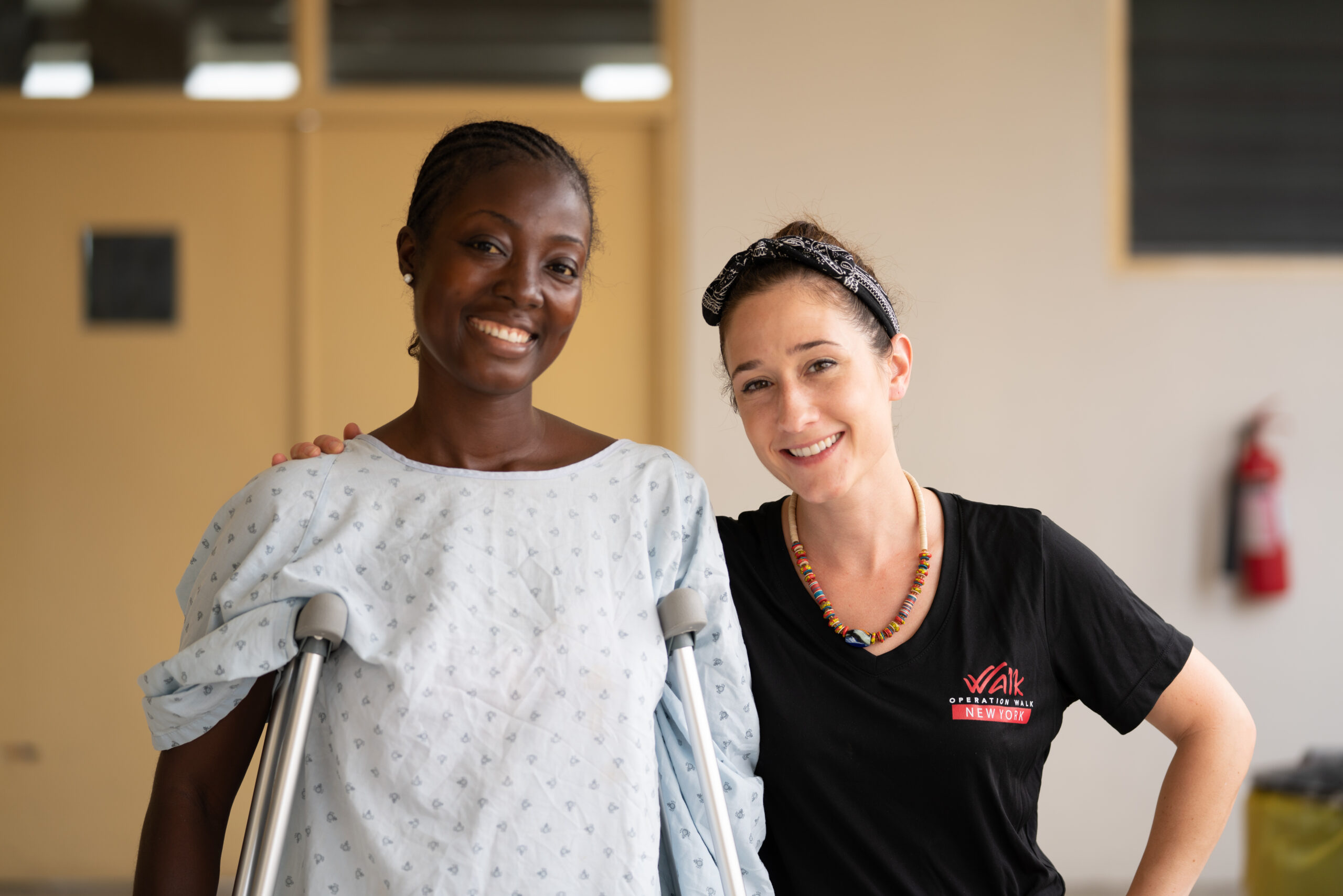
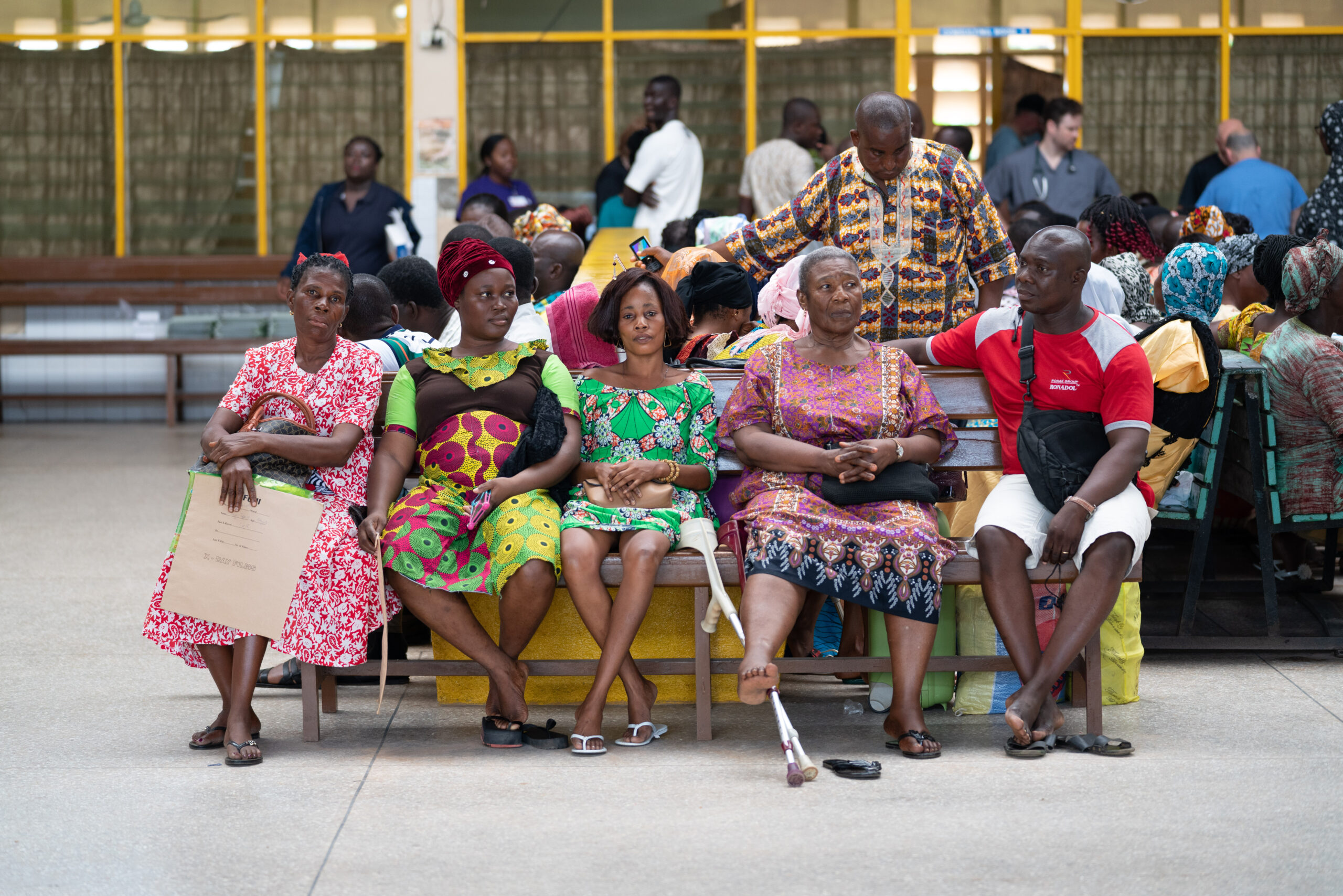
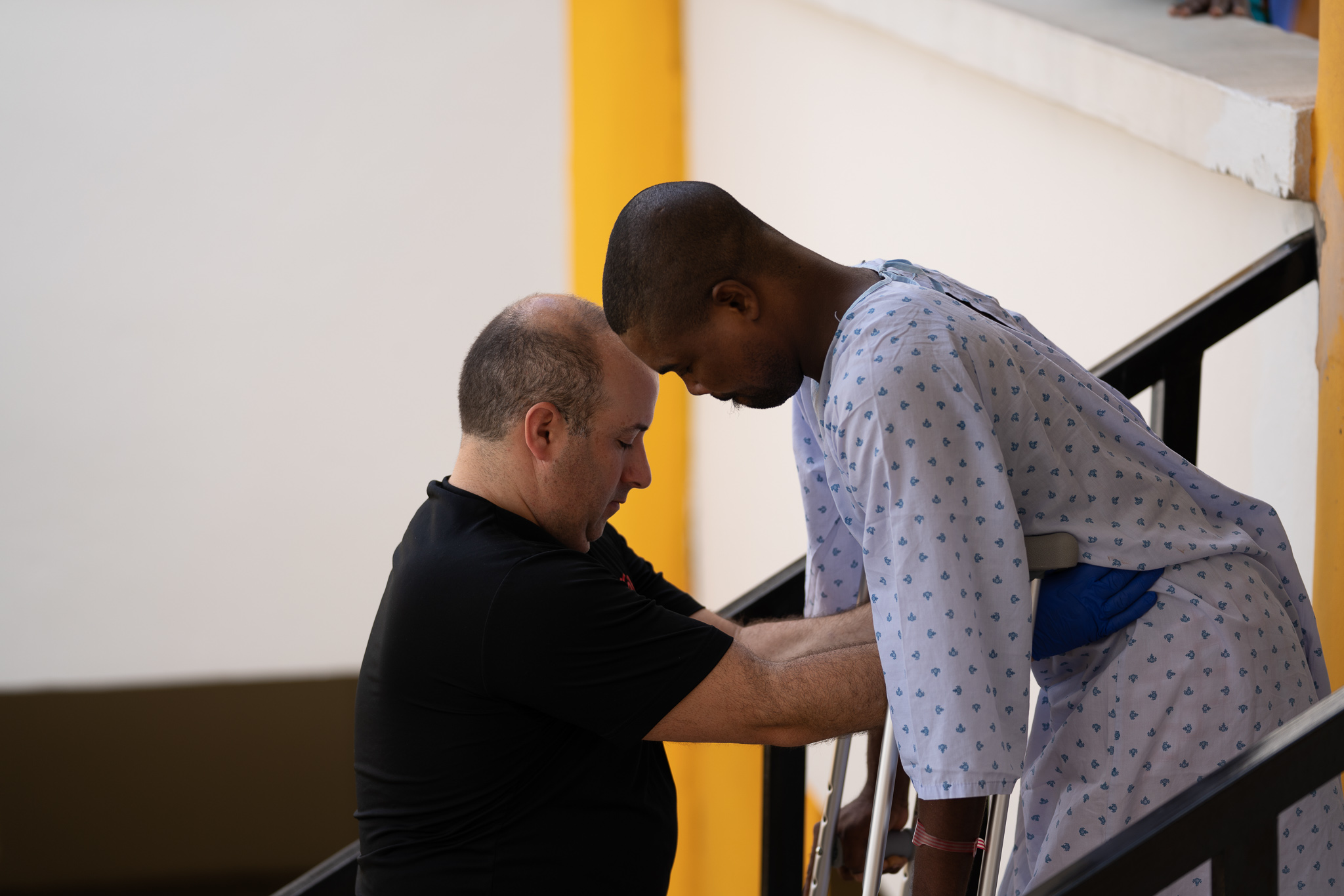
Our Mission Blogs for Ghana 2019
By Dr. Parker
October 24, 2019
The operating rooms are dark and the hallways are emptying at St. Joseph Hospital in Koforidua, Ghana. The patient wards are full of post-op patients who are working with the OpWalk physical therapists, learning the ins and outs of having a new hip or knee. Final rounds are being made, and final post-op x-rays are getting checked. And slowly, the Op Walk staff is drifting toward the front door.
Leaving is always bittersweet. New relationships are forged, the team has bonded closely, and patient satisfaction and appreciation are high. But we also hear the siren song of home, of familiar places. Of family. Of sleeping in our own beds.
Operation Walk comes down to the people who engage it.
First – our Ghanaian hosts, who bend over backwards to make us feel welcome, who mobilize indescribably to share the work that we pursue, and who politely answer every request we make with a soft “Yes, please.”
And our Operation Walk staff. The nurses and circulators, the scrub techs, the therapists, the equipment reps, the CRNAs, the residents, our new social media team, and our general volunteers (did I miss anybody? I truly hope not). Every year, these people take precious vacation time to go to bat for Op Walk. And every year, they absolutely outdo themselves. Every single member of the team brings their A game, and goes above and beyond to assure the success of the mission.
Special mention must be made of our ortho residents. This year we brought three residents on the trip, for what is probably the most challenging surgical experience of their year. And no one rose to the challenge more than the residents did. This trip couldn’t have happened without their hard work and tireless commitment, and our scrub caps are off to them. To Max, Mike, and Tyler – thanks, guys.
Great work.
To our surgeons, medical docs and anesthesia docs, and Op Walk Directorship: your dedication to this endeavor, and your willingness to offer your expertise to this patient population, is an inspiration. It’s an honor and a privilege to share this space with you.
And finally – the patients. The patients!
There’s not a way to describe the look on a patient’s face when they get up and walk for the first time on a straight, stable knee, or a hip that finally works like a hip should work. And seeing them take those steps makes all the effort of Operation Walk worthwhile.
There’s a lot that we each take for granted every day. Painless, functional joints must be at the top of the list.
Today we head from Koforidua to Accra, and tomorrow we jump the puddle to home, to waiting friends and family, to jobs that will suddenly seem just a little easier, and to the comforts of everyday living.
Thank you for following another chapter in our Operation Walk story. And please accept a simple challenge: if you have something to offer to others in need…give it to them. Just because you can. Their life will be better for it. And so will yours.
Operation Walk New York exists because of the generosity and support of people just like you – people who see the potential for good in the world, and work to make it happen. Thank you for your interest and your support.
October 23, 2019
I had a big steel mallet, and I was hitting an acetabular insertion device nearly as hard as I could – Clang! Clang! Clang! – but the cup just was not going into the pelvis quite like I’d hoped. The pelvic bone was just too hard. I took a few more big swings and then said to myself: “No. Wait. (Seth voice:) Something bad is about to happen.”
I backed off, reconsidered, and found a better plan. A plan which ultimately worked. Untoward incident avoided.
Around 6 pm tonight, Ghana time, Tyler, one of our Ortho residents, put the last sutures into the last hip replacement performed during our 2019 Operation Walk New York trip to Koforidua, Ghana – a trip that began with profound frustration about our sequestered cargo container, which finally arrived three days behind schedule, resulting in the truncation of our trip to about half its scheduled surgical days.
That being said: In two days and a short Monday evening session, we were able to do exactly 50 cases. We ran four rooms, each with two surgeons, and got through 5 or 6 cases in each room, on each day.
Replacing joints here in Ghana is challenging. As previously mentioned, the degree of pathology is off the charts compared to what we typically see at home. The easiest case here is akin to the hardest case we will see at home in months.
This is due to a combination of factors. Mostly, it’s two things: untreated trauma, and sickle cell disease. Traumatic injuries can be undertreated here, and it’s not uncommon to see a victim of a motor scooter accident or another mishap who has had a dislocated hip joint for months, or even years. And sickle cell disease causes osteonecrosis – literally: bone death – of the proximal femur (the hip joint “ball”) or distal femur (the dogbone-shaped top half of the knee), which make the bones both misshapen and also incredibly sclerotic, which means they are exceeding difficult to cut with a saw. The bones are hard, but also brittle. They don’t budge…until they break. Yesterday, I literally wore out a battery and a saw blade trying to replace a knee. I had to get replacements for each of those.
This simply DOES NOT HAPPEN in the US.
For joint replacement surgeons, the net effect is comparable to driving a car in a big blizzard or snowfall: the actions and input feel familiar, but can result in wildly different outcomes in a single moment, and sometimes without any warning. And somehow, it always surprises you.
This is our fourth trip to Ghana, and we are learning rapidly what it’s like to operate on Ghanaian bone – a process which took us very much by surprise during our first trip in 2016, but which we have become much more accustomed to now. Most US-based surgeons see a few of these cases at most. Here in Ghana we see 4-5 a day, every day. Every. Day.
So, like when driving a car in a heavy snowfall (I’m looking at you, Syracuse…), we proceed slowly and with great prudence, knowing that any misstep could lead us down an unintended path of travel. I don’t know about you, but I like my winter car travel and my surgical outcomes to be exactly the same: safe, efficient, boring, uncomplicated, and successful. And also: accompanied by some good music. Preferably not too loud, and not distracting. But just enough to keep me from singing the chorus of “Yellow Submarine” (or something…) over and over in my head.
From the moment we started unloading our cargo container on Monday evening (Wait: this will blow your mind. Know who helped us carry in a tractor trailer truck’s worth of boxes? Doctors, nurses, Anesthesia providers and physical therapists… and a couple patients whose joints we replaced last time we were here!! Yes… seriously. ), to the moment that last suture was thrown tonight, the staff of Operation Walk worked like a perfect machine. And 50 lives will be made better by those efforts.
Operation Walk New York exists because of the generosity and support of people just like you – people who see the potential for good in the world, and work to make it happen. Thank you for your interest and your support.
October 22, 2016
This morning, on the way to the hospital, one of our Operation Walk docs looked at me and said “…the moon’s upside down.”
And he’s right. Here in Ghana, the crescent of the waxing moon hangs in the sky like a big capital U, and not the big capital C that we get at home. And it only takes a second to realize: it’s not the moon that’s different. We are just seeing it from a very different place.
Things can look different when viewed from a new perspective. The things we think are normal, and take for granted, suddenly look very different when they are refracted though a new lens.
On a regular weekday at home in Syracuse,we might go to the OR and do a bunch of cases. It’s normal. It’s almost routine. I always tell my patients “You want your surgeon listening to music and talking about the weekend.” Just another day at the office. That’s perfect.
But here in Koforidua, there’s nothing routine about it. Taking over a regional orthopedic hospital and replacing as many joints as possible? That’s profoundly unusual for this part of the world.
After much tribulation, our cargo container finally arrived about 4:30 yesterday afternoon. A colossal effort was made on the part of our Op Walk people, as well as the wonderful employees at St. Joseph’s Hospital here, to unload the truck and unpack our cargo… and by 7:45 last night, we were cutting skin on joint replacements. We got 6 cases done last night, and another 24 today. And tomorrow we have another 20 scheduled.
I’d love to be able to accurately describe the beehive of activity that St. Joseph’s Hospital in Koforidua became last night, because it was striking to witness. But I simply cannot. 40+ people working hard in the African heat to provide surgical care to the population of an underserved region… And then the moment came when we wheeled our first patients from the wards into the surgical theater.
If you were the kind of person who became emotional about things, well… it would really make you emotional.
These trips are hard. Logistically, professionally, personally, emotionally. There’s really nothing easy about them. But you can be assured: all the usual cliches apply. And there’s not a single member of our team that’s doesn’t feel fortunate, honored, and genuinely humbled to be here doing this work.
Tomorrow is our third and final operative day. Despite the difficulties and stumbles with our cargo, we will still get in 50 cases. And those are actual lives touched, changed, and hopefully improved.
Operation Walk New York exists because of the generosity and support of people just like you – people who see the potential for good in the world, and work to make it happen. Thank you for your interest and your support.
October 21, 2016
When you pack a bag and prepare to travel to subSaharan Africa, there are some things you don’t expect to see. Among those things, one could include the Civil War battlefields around Gettysburg, PA. But for a group of us, our trip to Ghana started with a 5 hour van ride from Syracuse to Dulles International Airport, outside Washington, DC. From there, just a short hop across the pond finds you in Accra.
A little weather can cause big problems, as our Operation Walk team of over 40 learned late last week, when the first leg of our journey – Syracuse to JFK – was unceremoniously cancelled, and we were all left to scramble ourselves to Accra. Chaos, it’s fair to say, ensued. Van trips, rented cars, flights all over the eastern half of the US… each of us adopted a new itinerary. But flexibility won the day, and 36 hours later, we were all gathered here in Koforidua, ready to go to work.
On Saturday afternoon we held our screening clinic. Splitting into four teams, we evaluated 105 patients regarding both their medical and orthopedic suitability for hip or knee replacement.
Screening clinic is the busiest and most stressful day of our trip. It’s the time when we are made most aware that we are not in Kansas anymore. Communication challenges abound. And it’s the day when we see firsthand the depth and breadth of the orthopedic pathology that exists in this culture. The waiting area is always a sea of crutches, as patients and their family members wait patiently to meet our medical teams.
The easiest surgical case here is the hardest case we would see in months back home. The combination of sickle cell disease (which is very destructive to joints, hips especially) and untreated joint pathology (fractures, dislocations, etc.) makes the variety of potential cases complex and surgically challenging. And a significant aspect of the patient population also carries untreated medical issues, the most prevalent being uncontrolled hypertension.
So screening day also becomes the day when we sometimes have to look a potential patient in the eye and inform them that they are not a candidate for surgery. It’s a difficult and emotionally taxing moment for all involved. For them, and for us.
We screened 105 patients on Saturday, and then met as a team and reviewed each potential patient. The goal, of course, is to surgically correct joint pathology in as many patients as possible, in order to alleviate their pain, and improve their function and flexibility.
However, more flexibility is required. Because of a logistics snafu, our cargo container, which contains all of our surgical supplies, remains locked behind the gates of the Port of Accra. Though we have been in constant contact with various individuals and entities in the Customs Department, we are still waiting for the equipment we need to do the work. Our team is gathered and prepared, and our patients are screened and ready for potentially life-altering surgery. And now we wait.
Early this morning, we sent a small group to the Port of Accra in order to personally facilitate the process of releasing the cargo container. But without it, we are all dressed up with nowhere to go. We will know more as the day progresses.
Operation Walk exists because of your generosity. Thank you for your interest and support.
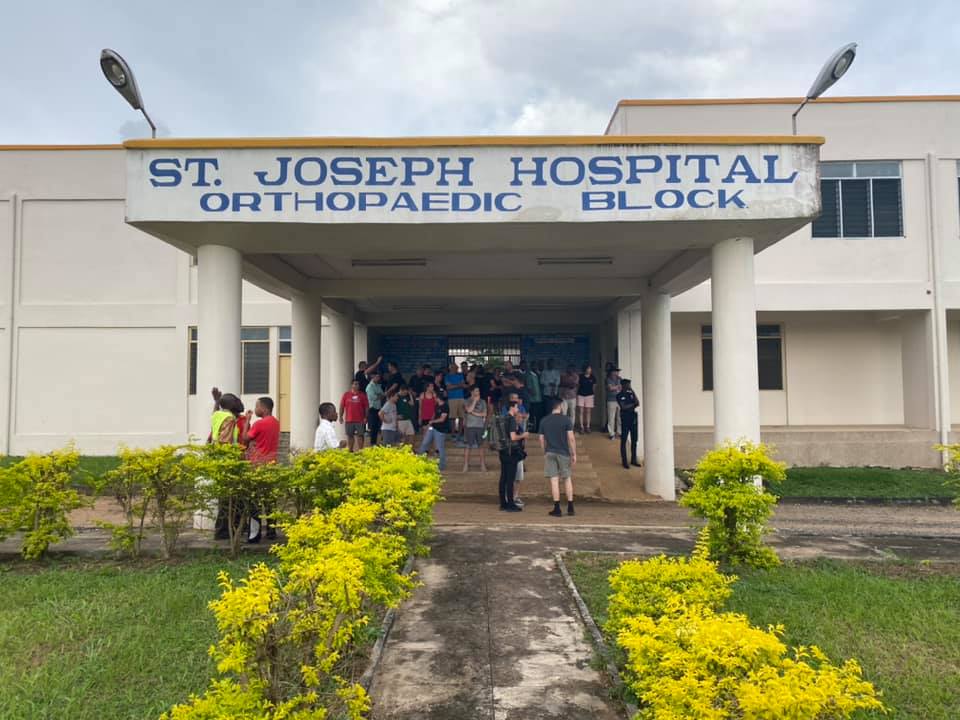
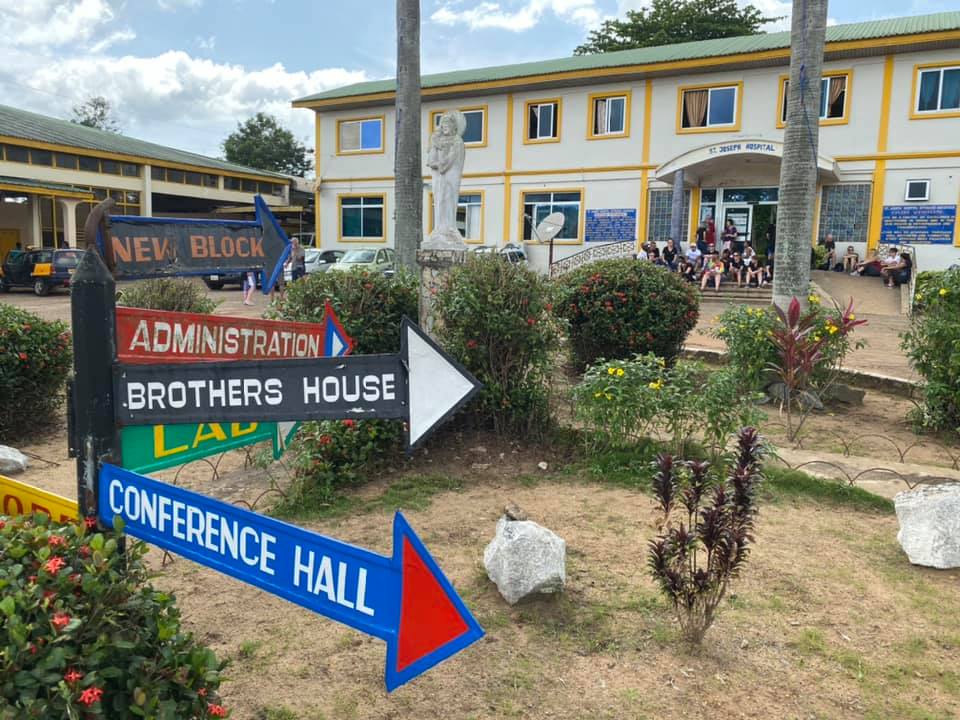
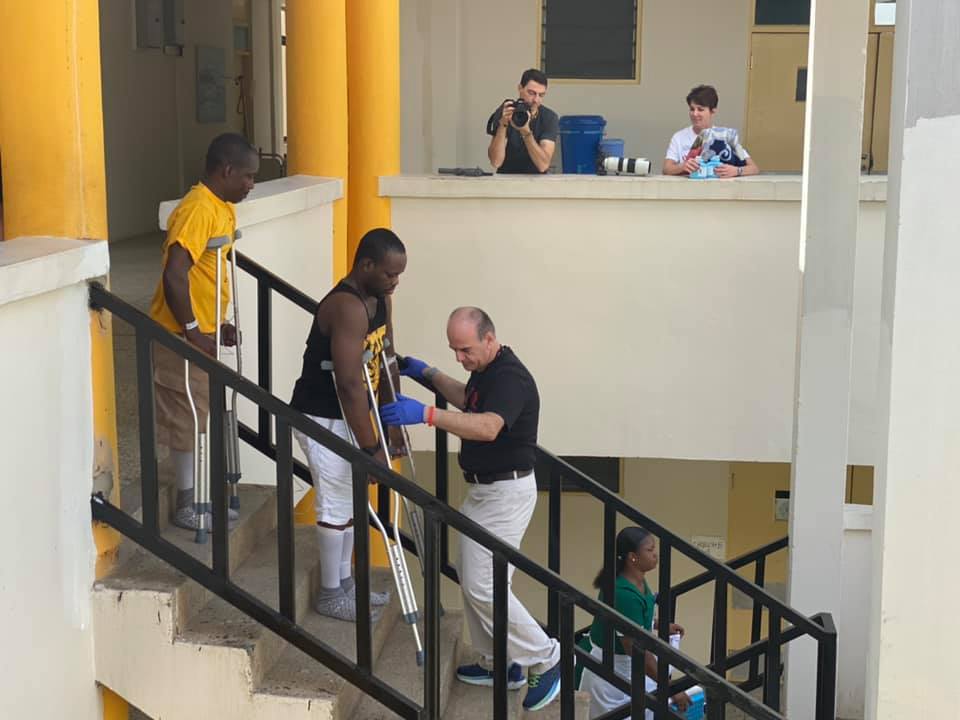
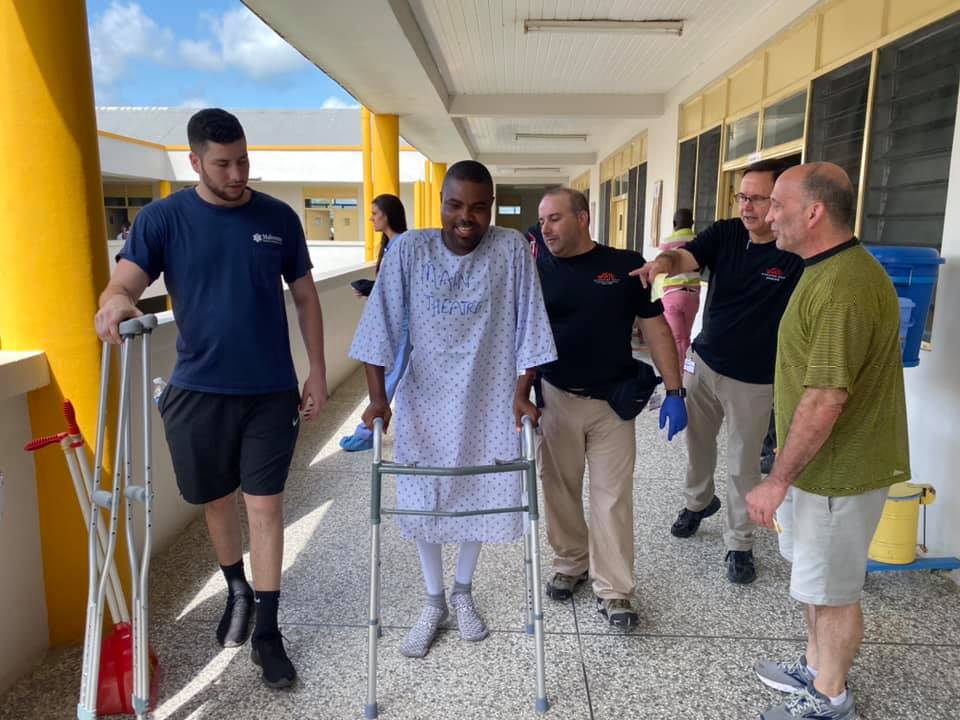
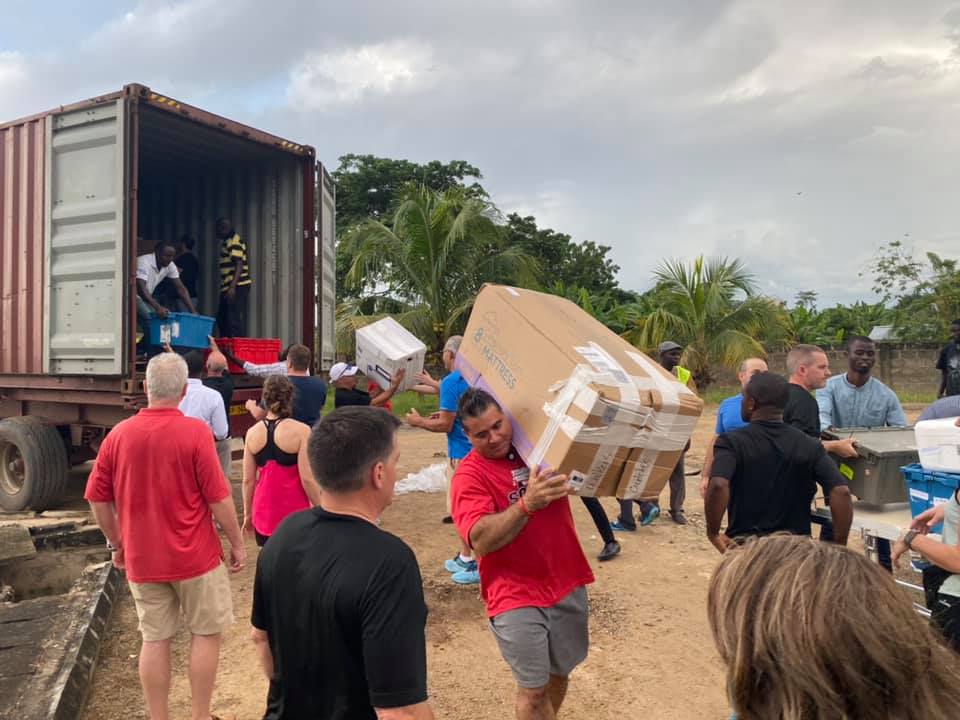
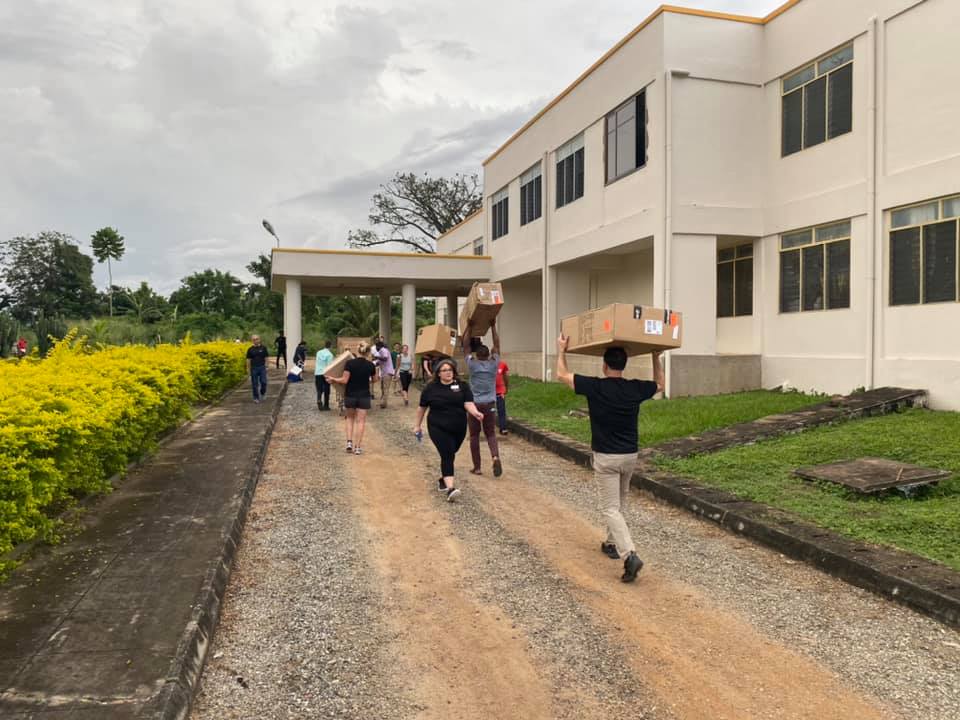
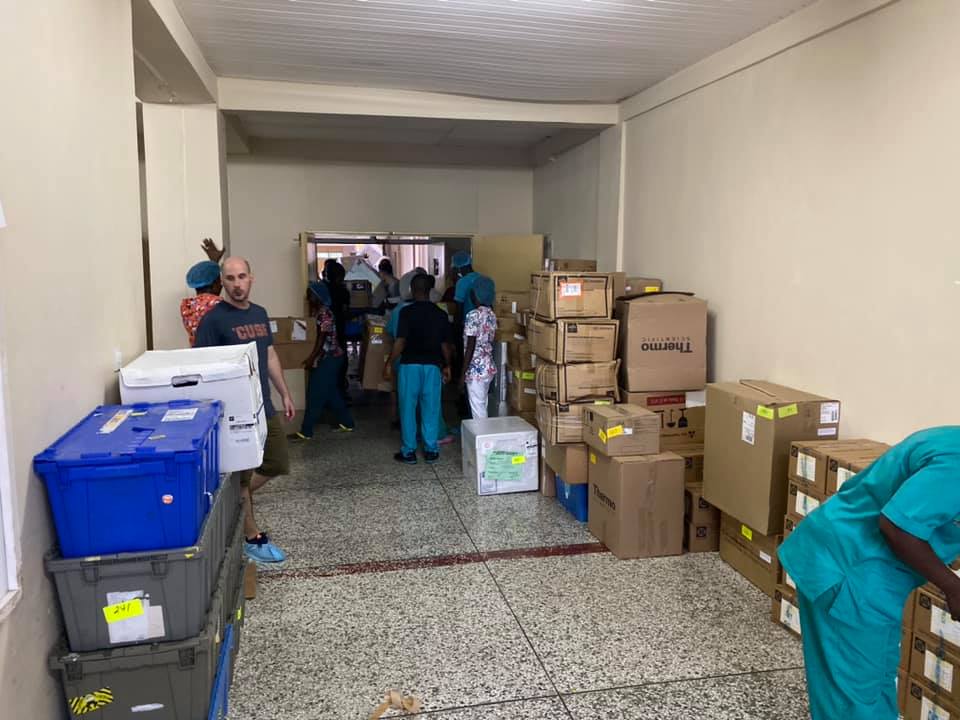
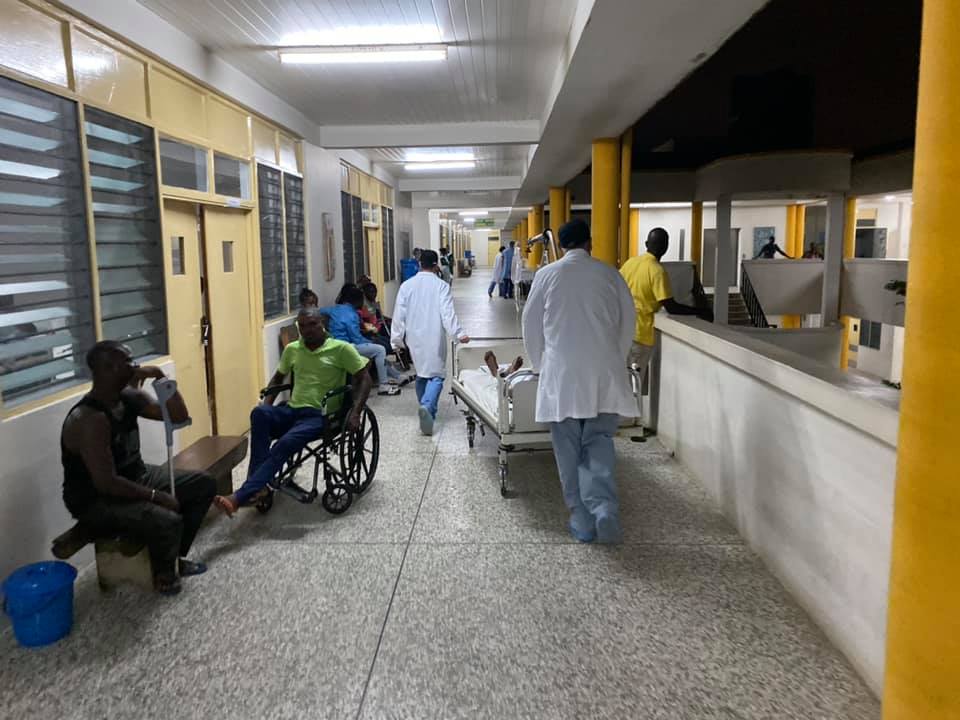
Thank you to the companies and organizations that generously donated supplies for our 2019 mission to Ghana.
Abbott Point of Care | Americares Medical | Outreach | Breg | Crouse Hospital | CNY Infusion | Ethicon | Johnson & Johnson
Lima Corp | Smith and Nephew | Seko Logistics Inc | SJHHC Foundation | Specialists Oneday Surgery | St. Joseph’s Hospital
STERIS Instrument Management Services | Teleflex/Arrow | Zimmer-Biomet
Ghana 2018
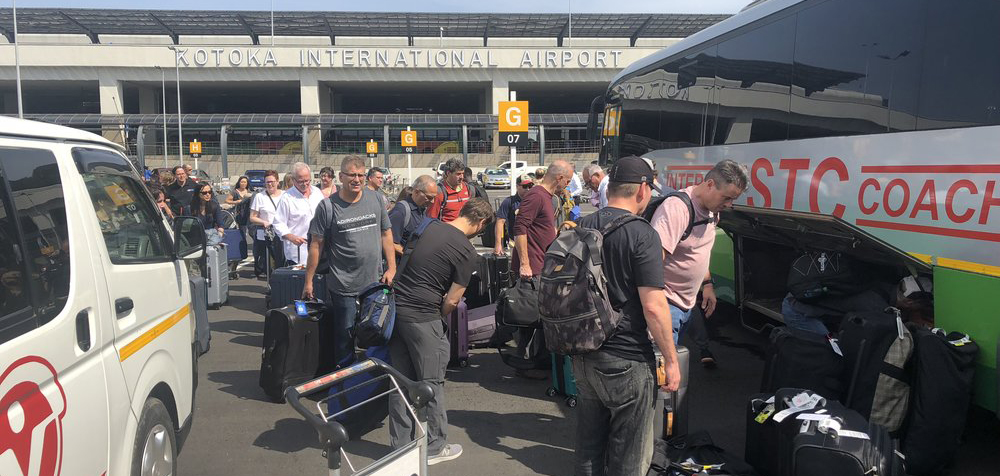
November 8, 2018
“The spinal is in. Let’s get the patient positioned.” I looked around for the hip positioner, that crucial and surprisingly complex instrument that keeps the patient stable on the bed during hip surgery. It’s hard to put a hip in straight without it.
After completing our four full surgical days late last night, we had arrived at St. Joseph Hospital this morning to break everything down, make our final rounds, and get out of Dodge. But then we learned that one of the hips we replaced yesterday had dislocated overnight, and, upon being put back in place, it came out again, suggesting that it was unstable. This is a thing: it happens. And at home, we take the patient back to the OR and reposition the cup, or lengthen the femoral component, and: Problem solved.
But here in Koforidua, the system was already dismantled, and so was the hip positioner. Our surgical equipment was already in boxes, and our big bus was iding outside the hospital. We were scheduled to depart very shortly.
“Here.” Our equipment person dropped a big black plastic box in front of me. Inside was a tangle of parts and components that vaguely resembled the hip position, but dissembled. Very completely dissembled. And I realized that reassembling the hip positioner was going to take longer than the operation. And I had no choice but to – for the first and only time in my career – put together the fricking hip positioner.
Let’s end the suspense: I got it together, we did the operation to reposition the cup and put on a longer head, the hip was stable, the patient recovered, and we made our bus in time without having to alter or delay our travel plans. Phew. But the experience drove home a couple truths.
First: Every process has a series of steps, and each step must be completed before the next can be undertaken. You can’t position the patient until you assemble the hip positioner correctly. This is true of most systems-based undertakings – surgery, flying an airplane, building a house. Learn the system, and its sequence of steps, and things will get easy.
And second: Sometimes, when you’ve got everything broken down, you unexpectedly have to put it all back together again. And you do it methodically, one simple step at a time. Maybe looking at the entire endeavor can be overwhelming. But break it down into manageable, bite-sized portions… and you can eat the whole enchilada.
The 44 members of Operation Walk Syracuse are en route back to the US. We have gone to new places, met new friends and colleagues, learned a great deal (the old-fashioned way) about the unique skeletal anatomy of the Ghanaian people, and, we hope, sprinkled some grains of goodwill over this part of the world. And we left 84 hips and knees way better than we found them. A few lives have been changed – and I’m not just talking about our patients.
It’s a tired cliché: we went somewhere and did something to help others, but in the end, it was we who benefitted most. Yawn.
But it’s all absolutely true. It’s not hyperbole to say that these trips are transformative for us. They let us view the world through a different lens, and this informs the work we do and the interaction we have back home. We are granted the enviable luxury of a formidable new perspective on what we do and what we have.
One last thing: our ranks have grown and broadened, and Operation Walk Syracuse has become Operation Walk New York. And we look forward to expanding our circle further in the years ahead.
We at OpWalkNY would like to thank you for joining us on this trip, and for making the whole thing possible, through your interest, support, and donations. As we hope you can tell, it is a remarkably good cause, one that is worthy of your support. Stay tuned for 2019, when we put the whole enchilada back together again.
November 7, 2018
This is our third trip in as many years to Koforidua, Ghana, and every day that we have worked here – every day – there has been a repetitive “thump thump thump” coming through the windows of St. Joseph Hospital.
Across the street there is a brickmaker. When we arrive at 7am, he is out there in his lot, making bricks. He makes them one at a time. He pours cement mix into sand, mixes it on the ground, then shovels it into a mold, and slams the mold cover down on it repeatedly. Thump… thump… thump. He makes a brick. He then lifts the brick from the mold and sets it out in the sun to dry.
He makes 120-150 bricks per day, and he sells each brick for about 12cidi, or $3 American. In Koforidua, that’s heavy industry.
He starts working around 6:30 am, and he is typically working when we leave, with darkness descending. So the soundtrack of the entire day is characterized by the regular “thump, thump, thump” of his brick mold.
It doesn’t take long to realize what exactly is made of these bricks in Koforidua: EVERYTHING. The streets are literally lined with unadorned gray brick buildings. The hotel we are staying in is made of them. The gas stations are made of them. So are the schools. The storefronts. The apartment buildings. And the hospital where we are working. And each edifice is built one brick at a time.
And there’s the thing: Each of us plays a small but crucial role in our larger realm. One individually-made brick at a time, we build a school, a bridge, a hospital, and a community. Thump, thump, thump.
That small thing that you do? It matters. Greatly. Because it’s a brick in a much larger structure. And if even one brick fails, the entire structure loses some degree of stability, and is at increased risk of collapse. Your role is crucial.
This week, OpWalkNY replaced 84 joints in Koforidua, Ghana. We made bricks from dawn to darkness, every day, all day. With the tireless help of our team members (nurses, techs, equipment reps, therapists, logistics team and everyone else… I really don’t want to forget anyone – they are all so important to our cause), we mixed the cement, shoveled it into the mold, and pounded them out. One at a time.
The fun of it is wondering where those bricks will go from here. What bridges will they build? What important structures will they go on to support? The world is a big place, Africa is a big continent, and it faces some big questions. And there is still a lot to be built.
Maybe you can’t build a bridge. But you can make a brick. And maybe Operation Walk can’t change the world. But it can change a life. And the possibilities from there are limitless.
Please once again accept our most sincere thanks for your attention and support. Op Walk works because you make it work. Because of your support, in the weeks ahead, someone will stand and take their first painless steps. And then go change the world. Or at least make a brick.
Thump. Thump. Thump.
November 6, 2018
When the power momentarily goes out in Operating Room 4, it seems like no big deal. The room goes a bit dark, though the windows provide some light. The suction and electrocautery machines go quiet. But we keep operating, mostly because: What other option is there? And the power typically comes back on in a few seconds. We make it work.
But that flicker of power has greater ramifications, because OR 4 is on the same breaker as the autoclaves – the enormous, modern machines that sterilize our surgical tools and equipment. And when the autoclaves go down, they require a much longer process to restart. And without those autoclaves, we are quite simply dead in the water.
We had an autoclave-related delay yesterday, and there was concern that today’s schedule might be truncated – or even cancelled – because the autoclaves would be down.
But it didn’t happen. The staff at St. Joseph Hospital in Koforidua, Ghana, pulled their boots up and kept the machines running. And today, our third of four operative days, working out of four ORs, we replaced 24 joints in 22 patients – 18 hips, including two sets of bilaterals, and 6 knees.
The experience of performing joint replacement here in Ghana is very different than at home. The patients are much younger, with an average age of around 30, and their deformities are profound – typically much, much worse than we see at home. And they come from much farther away. They get subcutaneous absorbable sutures for wound closure, as there would be no reliable way to have surgical staples removed at 10-14 days post-op, because their rural home is a 12-hour drive from Koforidua.
Then there is the issue of resources. Simply put, the most remote community hospital in the US gleams with technology in comparison to our St. Joseph’s Hospital in Koforidua. Every item in the hospital (like… EVERY item) bears a handwritten code which delineates what it is, where it belongs, and the year it was acquired. And those codes suggest that many of the items we use have been there a long, long time. It’s actually a pretty interesting sociological observation to wonder who else has sat in this chair, which is marked “SJH/THE/CHA 1987.”
But they make it work. A brief review of the surgical logbook here at SJH in Koforidua shows that they routinely perform orthopedic trauma cases – fixing broken bones which are shipped in from hours away. And hidden behind the well-used doors and windows here are serviceable surgical technology – autoclaves, lights, anesthesia machines – and a dedicated staff of medical professionals who reliably provide surgical orthopedic trauma care.
We have noticed this week that the hospital here seems to have improved notably since we first came in 2016. It’s been painted. The Snack Bar is open. It’s noticeably cleaner. And the surgical assistants who help us are capable and clearly experienced.
And if there is anything more charming and inspiring than happening upon a group of uniform-clad Ghanaian nursing student on the floors of the hospital, then I have not seen it. With their green uniforms and their broad and infectious smiles, they clearly tell a wonderful story about the future of medical care in Ghana. They’re making it work.
There has clearly been a flicker of power, and of light, here in Koforidua, and the healthcare machine seems to be up and running. Like so many regions of the world, Ghana has challenges. And we can’t change the world. But maybe we can help change some lives.
Thanks so much for your interest and your help. We are cranking as hard as we can to replace as many joints as possible during our brief stay.
Operation Walk happens because of you and your support. And we are immeasurably appreciative – as are our patients.
November 5, 2018
In the course of your life, you have learned the concept of force modulation. Through a process of trial and error, you have learned how hard to close a car door, how gently to open a sugar packet, how carefully to hammer in a nail, and how cautiously to pass a thread through the eye of a needle. It takes practice, practice you sometimes don’t even realize you’re doing. But anyone who has successfully obtained toothpaste from a tube knows what I’m talking about.
In orthopedics, we learn the same concept. Through a rigorous and well-governed training process, we learn how hard you can pound a hip stem into a femur, or how tightly you can turn a screw into bone. Sometimes – and this is a universal truth – we learn things the hard way. We learn to do it right by doing it wrong. But learn it, we do.
But imagine if you suddenly found yourself in a world where those rules of force modulation were suddenly inapplicable. You push a car door shut – and it barely moves. You go to open a bag of salt & vinegar potato chips, and it doesn’t open. So you pull as hard as you can AND IT STILL DOESN’T OPEN. Wait… what?
This is joint replacement surgery in Ghana. The bone we have learned to handle so carefully in the States is as hard as granite here. This is a result of genetics, and a pathological issue known as osteonecrosis – “bone death.” People with the sickle cell trait have a predilection to clotting crises, and this results in abnormally hard bone. And in some of these Ghanaian patients, the bone is literally like stone. We deplete batteries and wear down metal saw blades just trying to cut through their bones.
So the usual rules no longer apply. We have had to re-educate ourselves with respect to the amount of force we have to apply to our tools. (And – let’s be honest – educating orthopedic surgeons is no picnic the first time around, never mind the second.)
Today was the second of four surgical days. So far we have replaced 45 joints: 38 hips and 7 knees. We continue to see cases of a complexity that is almost never seen in the US. And, from this experience, we continue to learn how best to provide care for these patients.
Thank you, as always, for your attention and support.
November 3, 2018- Screening Day
It’s a hard thing to put a finger on, but part of the thrill of traveling is seeing the world through a different lens. In nations or cultures different from our own, things work differently. Road signs are different. Light switches are different. And the habits of communication are different. Experiencing these things, and figuring out how local systems work, are part of the challenge and excitement of being someplace new.
And, as a system, health care is indescribably complex. (“Who knew…?” We all knew.) And that system is always challenged to function efficiently in any culture.
So mixing these two elements together – trying to create a system that will allow the administration of a complex health care need like joint replacement, in a locale where every little thing is quite different – is a unique difficult undertaking.
Today is Screening Day. Working in four screening teams, we meet and examine about 140 patients, to assess their medical and orthopedic suitability to have a joint (or joints) replaced.
It’s on Screening Day that the exchange of information is most crucial, so this is the day where the differences between our cultures are most apparent. Communication challenges abound. Both we and the majority of the patients are all speaking mostly what we think of as English, but we commonly require the use of English-to-English translators.
And the Ghanaian voice, it seems, is commonly soft, and it’s often necessary to move in quite close to hear and understand what’s being said. In our American culture, it’s more common to step back, and speak up. This lends itself to a certain degree of cross-culture awkwardness (Except for Seth. Seth is a close talker).
Screening Day also makes an impression emotionally, when we see the pathology that these patients have been living with for so long. The easiest case of the week here is the hardest case in three months back at home. The degree of deformity and disability can be striking, and moving.
One 22-year-old presented with a dislocated right hip from a car accident, and his right leg was 10 cm shorter than his left. When asked when his injury occurred, he replied “7 years.”
Another young woman presented with two crutches and a ridiculous arthritic deformity in each hip for many years. And a broad smile. When we checked her age? 21.
In America, these extreme examples of orthopedic pathology are rarely encountered, simply because they get fixed way before they get this bad. But in Ghana, they are much more common.
Patient screening is followed by a long conference in which our entire surgical team reviews each case and discusses the appropriateness of surgery for each patient. X-rays are reviewed and patient comorbidities (malaria, sickle cell disease, hypertension, etc.) are reviewed. Surgical candidacy is narrowed down to a number that our resources can accommodate. Then a smaller team sits down and puts together the surgical schedule for the next four days.
While we screen patients, our OR prep team is working hard to create a small area of familiarity for us in the operating rooms. This is a crucial component of our success – surgically, we will do our best to play our home game. And tomorrow, as we move from screening into our first of four consecutive surgical days, running three rooms, we will pursue the actual surgeries with as much routine and normalcy as we can.
In Ghana.
As always, we thank you for your attention and support. Operation Walk works entirely because of supporters like you.
November 2, 2018
International travel can be taxing. Pack all your stuff, get it to the airport, get through security, get on the plane. Fly. Get off the plane, get through customs, find your bags. Then, ground travel to your destination. All with a not-insignificant dose of discomfort and sleep-deprivation.
But the stress of travel can be offset by enthusiasm, by the excitement of arriving at a new destination, and experiencing a different culture.
Both of these aspects are magnified in the context of Operation Walk. Months of planning have resulted in today’s arrival of the 44 members of our Operation Walk team in Koforidua, Ghana. In addition to our team members and all their stuff, we arrive with enough gear and medical equipment to replace as many hips and knees as possible, over the next week.
Our group consists of nurses, surgical techs, equipment reps, anesthesia providers, physical therapists, logistics people, and seven surgeons.
Tomorrow is Screening Day, when we will examine and screen about 200 potential hip and knee candidates. Then, over the ensuing four days, we will work as a team to do as many cases as we can, before breaking it all down and heading home late next week.
This is our third trip to St. Joseph’s Hospital in Koforidua, and our relative familiarity with the locale and the hospital will lend itself to efficiency, an efficiency we hope will allow us to do as many surgeries as possible.
Tonight we are settling in at our local accommodations (“Early bedtime! Everybody’s tired.”) and preparing for the busy days ahead.
We at Operation Walk New York are grateful for your attention. Thank you for your support! More to follow.
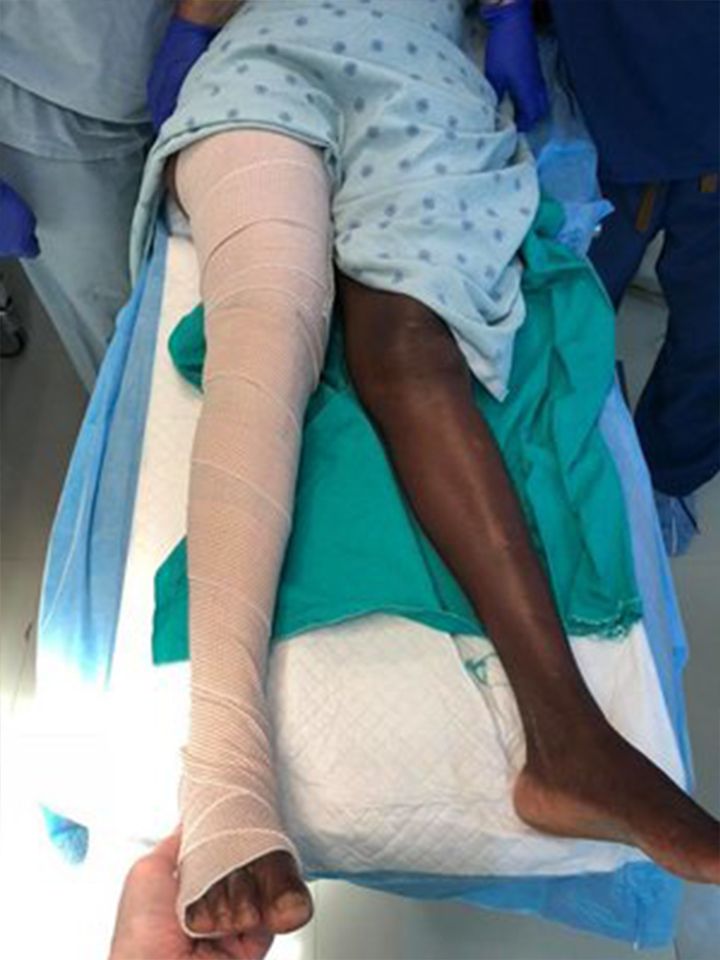

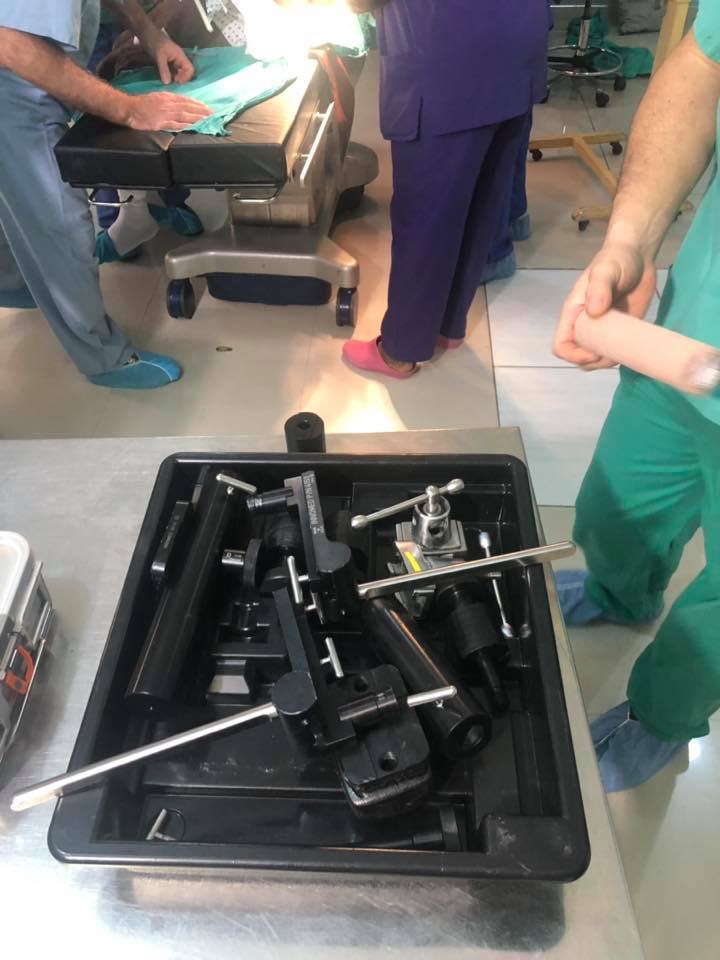
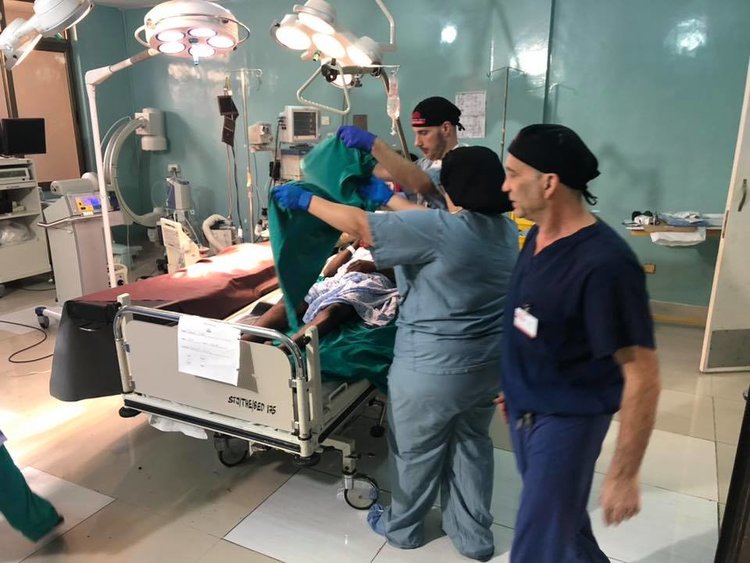
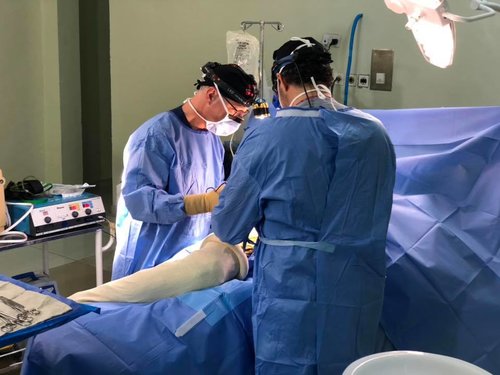
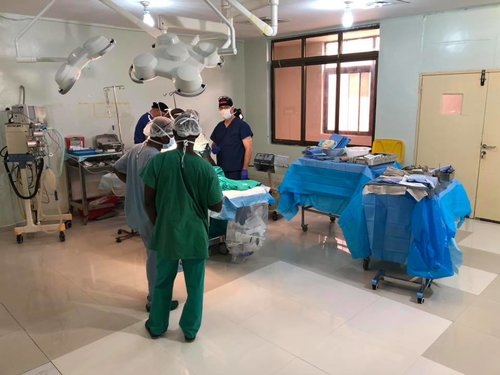
Guatemala : 2015 & 2016
The Operation Walk Team from Syracuse traveled to Antigua, Guatemala in 2015 and 2016 to perform life changing surgery.
Guatemala in 2015 and 2016
Guatemala Capital: Guatemala City, 1.075 million (est.)
Population: 15.47 million
Average Life Expectancy: 71.66
GDP per capita: $3,477 (USD)
Monetary unit: Quetzal
Population below poverty line: 54%
Languages: Spanish 60%, Amerindian languages 40% (There are 23 officially recognized Amerindian languages)
Exports: Coffee, Sugar, Petroleum, Apparel, Bananas, Fruits and Vegetables, Cardamom
Geography: The northernmost of the Central American nations, Guatemala is the size of Tennessee. Its neighbors are Mexico on the north and west, and Belize, Honduras, and El Salvador on the east. The country consists of three main regions—the cool highlands with the heaviest population, the tropical area along the Pacific and Caribbean coasts, and the tropical jungle in the northern lowlands (known as the Petén).
Screening
X-rays and patients arrived the day after we arrived and set up our operation, and were screened for surgery. Over 100 patients will arrive hoping to be selected, and are given physical exams to make sure they are good candidates for surgery. The Guatemalan people do not have access to RA modifying medications, so younger patients, even those in their twenties have already had sufficient joint degeneration to require surgery.
The doctors then met to evaluate and choose the best candidates for surgery. While the screening clinic is being held with prospective patients, the rest of the team is setting up the operation room supplies to start surgery bright and early the next morning. Surgeries will be done for the next 4 days from 7 am to 6 pm.
Surgery and Recovery
The doctors performed many hip and knee replacements a day in order to help as many patients as possible.
After surgery the patients are monitored by the nursing staff and then encouraged to work with physical therapists to get up and try out their new hip or knee. Most are happy to do so!
After two days, most are released to go home and continue to work on their recovery and their new beginnings.
Because of this life changing surgery, our patients can now lead pain free and productive lives!
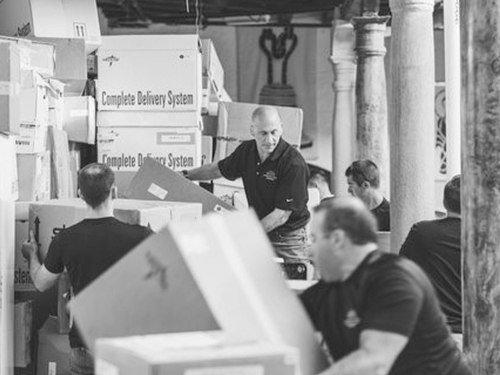
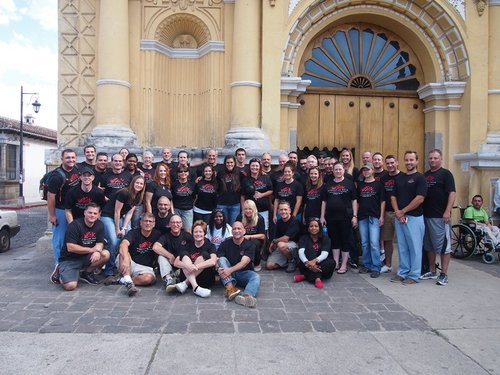
Our Mission Blogs for Guatemala 2016
September 29, 2016
Today, 44 people traveled from the US to Antigua, Guatemala for Operation Walk New York (also known as Operation Walk Syracuse). Doctors, nurses, scrub techs, physical therapists, anesthetists, equipment reps and personnel… here we go again!
But how does this happen?
The world wakes up slowly. Its true for all of us, for each of us. We stir, we wake, we take the first breath of this day, our next day. It’s dark. Our eyes open, and consciousness arrives. What’s today? Thursday. What am I doing today?
Oh. Airport. It’s time to go to the airport.
Most of us are familiar with early-morning travel. It’s dark. It’s dark when you wake up, it’s dark when you get to the airport, it’s dark when you board your first flight. You squint at your boarding pass with tired, hollow eyes. Coffee.
It’s a remarkable thing, then, to arrive at your gate, still in the dark wee hours, to find 44 friends and colleagues congregated, smiling and energetic. Excited.
Once again, I am left to marvel at the fact that it’s possible to wake up in New York, and have dinner in Guatemala. Seriously… take a look at a globe. Find Syracuse, and then find Guatemala. If this fact doesn’t astound you, at least a little, then you’re not really thinking it through all the way.
And I am left to marvel at the commitment that these individuals share for the betterment of others.
Over the next 8 days, OpWalkNY will meet and engage the Guatemalan culture, turn our attention to those with the most profound orthopedic needs, and then – replace joints, replace joints, replace joints.
Here we go again.
October 1, 2016
In a typical week at home in the SOS office, it’s likely that we will see one or two people with some really profound orthopedic pathology. A really crooked knee, or a really deformed hip. It’s not exactly rare, but it’s unusual… mostly because in the US, really bad pathology gets fixed early on.
Not so in Guatemala (or Ghana, or Nepal…). In underserved countries such as these, profound orthopedic pathology just gets lived with, sometimes to an astounding degree.
The take-home: a high percentage of patients we see here present with really impressive pathology. Their knees and hips are truly awful. Crooked, painful, and profoundly dysfunctional. And they are truly disabled.
Today – our first full day in Antigua Guatemala – was Screening Day. By 7 am, the hospital filled to overflowing with potential patients, the hallways a jumble of crutches and canes and walkers. Then, one by one, each patient was interviewed and examined by our Med/Surg teams, and their potential to have a safe and effective surgery was assessed.
This all sounds simple enough… until one considers that each team consists of two surgeons, an anesthesia provider, a medical doc, a nurse, and an interpreter. X-rays are reviewed, patients are examined, the medical chart and history are reviewed, any necessary additional tests are ordered, surgical risks are reviewed, and consent forms are signed. And all the while, every piece of related information is being translated from Spanish to English, and then translated back again. And this process is repeated over 100 times. This is then followed by a conference where each case is discussed and the details of each surgery are considered.
So… it’s a busy day.
The single most impressive feature of this patient population is simply this: the patients and their families are so nice. So appreciative. So thoughtful and patient. They are, without exception, a pleasure to care for. And this sentiment is repeated among our staff over and over again.
At one point, we apologized to a woman who had waited over three hours to be screened. She smiled and said “It’s okay. I have already waited 10 years to have this operation.”
Inevitably, there are patients who are turned away. Either their pathology is too complex, or their medical status is too compromised, and they are simply sub-optimal surgical candidates. We do what we can for them – new crutches, a brace – but we have to send them away without the operation that may improve their lives. And even those patients smile, and shake hands, and express profound appreciation. This is perhaps the most moving demonstration of this culture’s perspective on Operation Walk.
Screening day is over. The surgical schedule for the next four days is being finalized. Tomorrow morning, we begin our surgical interventions in earnest. But already, the trip feels like a tremendous success – mostly because of the nature of the Guatemalan people.
Tomorrow: surgery day numero uno. Respiré profunda, Señor!
October 2, 2016
It’s about the people.
Hard to elaborate. But I will try…
In April, Operation Walk Syracuse went to Ghana, in sub-Saharan Africa, and traveled deep in-country to provide joint replacement surgery to a population of people who otherwise would never have access to that kind of technology.
And, this fall, currently, Operation Walk has traveled, once again, to Antigua Guatemala, to provide the same life-altering joint replacement surgery to a population that otherwise might never experience the benefits of that technology.
Over the past six months, I have tried to write objectively about this experience, because it is an incredible experience, and words simply don’t describe it adequately. No, really… it’s AMAZING.
However, as I walk upon the cobblestoned streets of Antigua Guatemala, a city renown for being one of the oldest in the Americas, I must face the truth that this Operation Walk trip is very different from that which visited Ghana in the spring.
There. I said it.
Ghana, as a nation, is perpetually at risk,: from poverty, from governmental disruption, from radical religious fundamentalism… but Ghana possesses a populace that is overwhelmingly appreciative of our contributions. The people of Ghana were truly indescribably appreciative of our efforts.
72 short hours in Antigua Guatemala, Guatemala have demonstrated that this is a nation with resources. I just spent an hour in a bustling nightclub in Antigua Guatemala.
*(OK. I am going to clarify one thing: the name of this city is “Antigua Guatemala, Guatemala.” There is NO COMMA between those first two words. Listen: I was an English major back when correct pronunciation and punctuation really mattered. I am getting it right. Wlads: trust me.)
Antigua Guatemala It is among the most beautiful and charming cities on the globe, and its populace, driving their Volkswagen GTIs and Lexus crossovers… they get it. Seriously. They get it.
Remember Columbus? (See also: Columbus Day…). Columbus came through here. Granted, Columbus was a busy guy. He sailed from Spain… he enslaved hundreds…). He saw a lot of central America, and he probably saw more than he documented. But when you hear that Antigua Guatemala is one of the oldest cities in the Americas, you can believe it. It’s amazing, and you should check it out.
Today, our first surgical day, we replaced 16 joints, in patients who otherwise would have never experienced joint replacement technology. Some had postoperative pain. Some had postoperative nausea. One guy, in his 70s, had both. Not pretty. But his right knee was straight, for the first time in 50 years.
It’s about the people.
In Ghana, we replaced joints in people who had no money. They had no opportunity for advancement. They had nothing but a wildly crooked knee, or a horribly dysplastic hip, and pain. And when we left, they had none of those things.
In Guatemala, the same people had hip or knee replacement surgery, and, for the first time, they had a straight leg, they had a knee or hip that moved normally, and they had pain.
And that is literally all they had in common with their Ghanaian counterparts.
In Ghana, we rode in a van from the barbed-wire-reinforced hotel to the barbed-wire-reinforce hospital, and back.
And we replaced joints.
In Antigua Guatemala, we have walked the charmingly cobblestoned streets of Antigua Guatemala, from a lovely Italian restaurant, back to our four-star hotel with a feather bed and 102 channels of cable…
…and we have replaced joints.
… and I can tell you… our interaction with the patients has been EXACTLY THE SAME.
It’s about the people.
They get it.
Maybe they have nothing. Maybe they have a little more than that. But not much more.
But they have need. They have a bad hip or knee that’s simply impossible (no… IMPOSSIBLE) to live with. And we fix that.
Hey: We FIX that.
Today we replaced 16 joints. They all did great. That’s pretty cool. Tomorrow, we are going to replace 20 joints. That’s about 20% more cool. Anyway you slice it… It’s pretty freaking cool.
It’s about the people.
Whether they have nothing, or whether they have a little something… they need our help. And we can provide it. That’s amazing. That’s a gift that few people can provide. We are incredibly, immeasurably lucky.
By giving, we receive. (Come along with us…)
Today was surgical day number one. Tomorrow is surgical day number two. I am sitting on a dark street curb, on a beautiful, cobblestoned street, in the oldest city in the new world. And tomorrow, I will help replace 20 joints.
It’s about the people.
October 3, 2016
Our time at San Obras Sociales del Hermano Pedro is passing quickly, and tomorrow (Tuesday) is our last surgical day. Today we did another 21 surgeries, for a total of 57 so far. The OR had been bustling, and as the days have passed, the Hopital San Obras Sociales del Hermano Pedro has gradually filled with post-operative patients.
It’s an interesting place: it’s rustic, but well-maintained and strongly staffed, and extremely clean. The hospital hosts mission trips all year, and the personnel are excellent in their care for post-op patients. This has been a welcome change for our medical docs, nurses and therapists, because the locals are already quite adept.
Our Operation Walk staff remains the brightest spot in this experience. In the OR, on the wards, and in the storage areas, they continue to work tirelessly to provide care for our patients. And it becomes more impressive when one considers: each member of our staff is using personal vacation time to undertake this endeavor. Without their dedication and commitment, there simply could be no Operation Walk. Our surgeon’s caps are off to them.
Interestingly: The combination of an adept hospital staff and an OpWalk staff that is using vacation time lends itself to a unique concept for us here: there is actually some free time to explore Antigua Guatemala and see some of the local sights. Over the course of the week, we have had the opportunity to get out into the city, interact with some of the locals, and enjoy the charming streets of Antigua Guatemala. It’s a unique city: there is no place quite like it in the States. It combines the old-world feel of Europe’s oldest cities with a sort of Caribbean low-key lack of urgency. The result is a friendly, approachable city that is a pleasure to explore. I would genuinely like to come back with more time to spend.
Tomorrow we wrap up our surgical days here, and then comes the process of breaking down the traveling circus that is Operation Walk and making our way home. This has been another incredible experience for us, and it’s thrilling to think that we leave behind better lives for other people. That makes OpWalk a win-win: our patients see the benefits of first-world orthopedic care, and we come away with the humbling gift of having the chance to work toward the service of others. And I honestly can’t say who is getting the better deal – because from this side, it’s pretty great. The gratitude shown by our patients is truly matched by the gratitude we have for being able to care for them.
October 5, 2016
There is risk in all things.
Each of us, at any given moment, is embracing some degree of risk. Usually, it is modest. Driving a car, riding a bicycle, crossing a busy street… these things are not completely risk-free.
And with risk comes reward. The willingness to accept risk stems from an understanding that our lives may be bettered or our circumstances improved by enduring that risk.
Sometimes, we choose to put ourselves at a greater degree of risk, in order to reap a potentially greater reward. One might choose to leave a stable job in order to pursue a higher paying position, or make a financial investment in hopes of achieving greater gains.
Choosing to undergo surgery reflects this risk/reward ratio perfectly. And nowhere is this relationship more transparent than in the surgical setting of a country like Guatemala.
The patients who undergo surgery with Operation Walk Syracuse are at significant risk, for a few obvious reasons. First, all surgery has a degree of risk (the term “minor surgery” is an oxymoron). Additionally, their surgical pathology is extreme, and the surgeries that they require are sometimes quite complex. So the decision to undergo that degree of surgery can be painstaking.
In many cases, though, the limb or joint on which they are choosing to have surgery is profoundly dysfunctional. And that in itself is a significant risk. In such a case, the decision to live without surgery presents a higher degree of risk than having the surgery. And with no surgery, there is no potential for the reward of an improved life.
For each potential surgical patient, even here in Guatemala, the sweet spot in that risk/reward ratio is a moving target. And each potential surgical candidate must think long and hard about the risks of surgery versus the risks of not having surgery.
One of our first surgical patients of the week was a 72-year-old man with advanced arthritis in both knees. Seeking to minimize his potential surgical risk, on our first day we replaced just his right knee. That leg was immediately improved, but his arthritic left knee still left him dysfunctional. So yesterday, our fourth and final surgical day, at his request, we took him back to the operating room and replaced his left knee, too.
The decision to have not just one, but two major orthopedic surgeries in the span of four days is a pretty big decision. It is a significant risk. But this morning, on rounds, he was smiling and appreciative, and obviously delighted to now have the opportunity to improve his quality of life. He was willing to endure the significant risk in order to reap a larger reward.
Each of us stares down this risk/reward ratio every day. For the patients of Operation Walk Syracuse, the risks may be significant, but the rewards are much more significant. And for us, it is an honor to help these patients balance risk with potential rewards.
The stalwart staff of Operation Walk Syracuse is spending today repacking boxes and equipment, and helping our post-op patients prepare for their new lives after our departure. For those patients, the risks have been endured. Now they can set their sights on the potential of great rewards.
And, once again, our hats are off to the OpWalk nursing, therapy, surgical and support staff who work so hard to make those rewards possible. Thank you, thank you, thank you.
October 6, 2016
Connections.
The work of Operation Walk in Antigua Guatemala is complete, and the team is congregating to board the buses back to Guatemala City. As Hurricane Matthew pounds the East Coast of Florida, we hope to slip above it and make our connection in Atlanta.
But whether or not we make that connection, we have made connections this week that will endure.
First, it’s impossible to come away from this week of patient care without making connections with those patients.
Clearly, they understand and appreciate the care they have received, and it has the potential to be life-altering for them. But what they may not realize is how life-altering these connections are for us. Because in no context does it become more clear that by giving, we receive.
In short, Operation Walk has been good for Guatemala, and it has been equally good for us.
And as we board the buses to depart Antigua Guatemala, it takes only a moment of eavesdropping to understand the remarkable and strong connections we have made with each other. There is laughter. There is good-natured ribbing and joking. And there is simply no hesitation to pile into these Guatemalan-sized bus seats right next to a team member who, 8 days ago, was an “acquaintance.” But now, after working and laughing side by side for the week, we are friends – close friends – and the closeness of these tiny seats is a non-issue.
And those connections will endure when we get home and see each other in the familiar hallways of the hospital, and will spill over into the patient care we provide in that environment. Make no mistake – Operation Walk improves the care provided to our patients at home.
These OpWalk people… Each has his or her story, a story that has led them to Operation Walk. I have seen them early in the morning, and late at night. I have seen them under duress, working hard at hard jobs in the service of people they do not know, and will never see again. I have sat with them at breakfast, then at lunch, and then again at dinner. And I have come to appreciate the qualities in those people which make them the capable, dedicated professionals that they are. They are, each in their own way, leaders. And I am honored and humbled to work side by side with them… in Guatemala, and in Syracuse.
Traveling – being away from the comforts and routines of home – has a way of heightening our awareness and emotional responses to things. Our experiences become more vibrant, more stimulating. As such, it’s difficult to stay objective when considering these new connections we have made. But a few final statements must be made.
First, to the leaders of Operation Walk Syracuse, I know I speak for all of our OpWalk team members when I say: Thank you. The opportunity to participate in this experience defies description, and we are more appreciative than we can say. We are changed for life.
Second, to the people of Antigua Guatemala, and especially to the hospital staff: Thank you. Your hospitality is unparalleled, and we could not have made this effort happen with you.
And last, and most important, to the generous donors and to the staff of Operation Walk Syracuse: Wow. Just… wow. The lives you have touched, and the difference you have made for your patients… these are the essential hallmarks of Operation Walk. You ARE Operation Walk, and without you, it simply doesn’t exist.
The quaint cobblestones of Antigua Guatemala have been replaced with the bustling energy of Guatemala City. Next stop: Atlanta, and then home to the Big Orange. Thank you to the followers and supporters of OpWalk. Your support makes this possible, and you have changed the lives of our patients.

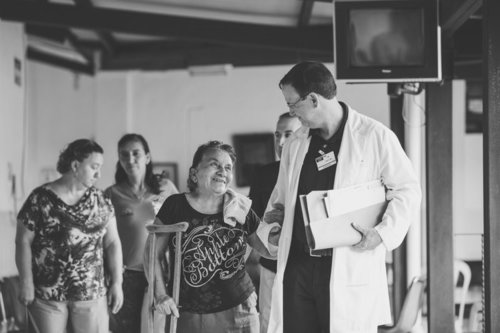
Ghana : 2016 & 2017
An Operation Walk team of 25 in 2016 and 44 in 2017 have traveled on a 10 hour flight to Accra to help those who have no hope or resources to lead productive lives without our help. Dr’s Brett and Seth Greenky, Tim Izant, Stephen Bogosian, John Parker, Luis Castro, Greg Kenien and doctors from Chicago and Boston joined our team along with Anesthesiologists, Nurses, Physical Therapists, Surgical Techs and other professionals that comprise the Operation Walk team. All of these people put all their time and efforts for 8 days into helping the people of Ghana. The team worked out of St. Joseph’s Orthopedic Hospital.
Ghana in 2016 and 2017
Population: 24.2 million
Average Life Expectancy: 60.95
GDP per capita: $1,858 (USD)
Monetary unit: Ghanaian cedi
Population below the poverty line: 24%
Languages: English is the official language.
Exports: Gold, cocoa beans, and timber products. Others include tuna, aluminum, manganese ore, diamonds, and horticulture.
Logistics
All the equipment that was set up in 4 Operating rooms was brought, donated by implant and pharmaceutical companies or paid for by our team with donations collected through our fund raising efforts. Six tons of cargo took 1 month to be shipped by freighter ahead of our arrival and was waiting for us to unpack when we arrived.
St. Joseph’s Hospital in Koforidua was where hundreds of prospective patients came from all over Africa for a chance to have our team perform a joint replacement that will change their life.
A screening took place of all who come to find out who is most in need of our life-changing surgery. Over 100 people came to be screened, but only 50 are able to be chosen for surgery.
The Goal
Many young people, as young as 17 will need hip or knee replacement surgery to help them live without pain and provide them a chance to restore their ability to walk, to provide for themselves and their families. Surgery is very difficult and takes a long time due to the strong bones that are inherent from their environment. There is a sickle cell trait is inherent in many who come, and it contributes to their need for joint replacements as young as 17.
Outcome
We performed 4 full days of surgery in four operating rooms starting at 7 am and sometimes finishing by 7 pm each day if everything goes smoothly. Surgeries were performed with the local team present to provide a hands-on educational experience and to care for our patients to continue the healing process once we return to the USA. In total, 118 joint replacements for 107 patients were performed between the 2016 and 2017 trips.
Everyone who goes on the mission trip is a volunteer, paying their way, using their own time in order to help those who would not be able to receive this care in their country.


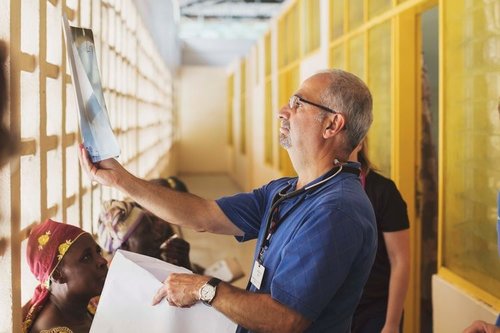
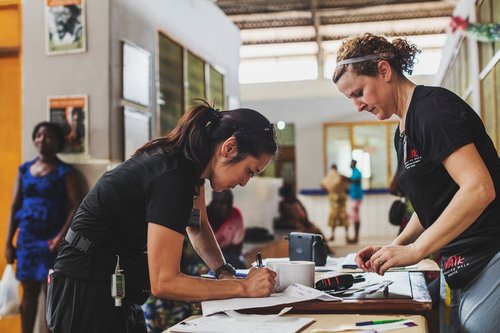
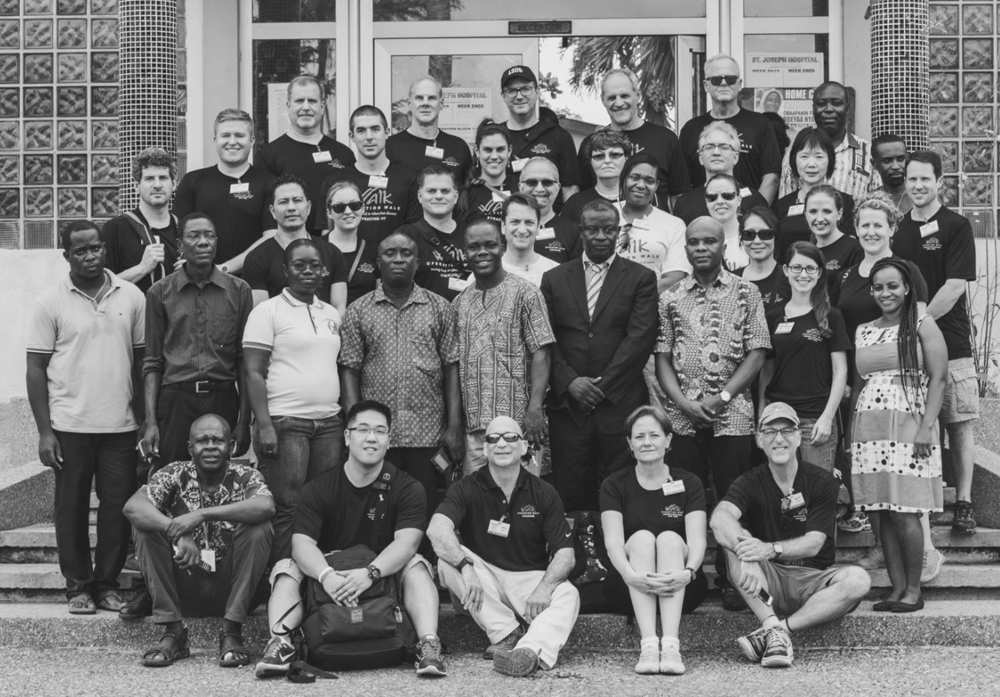

Our Mission Blogs for Ghana 2016
By Dr. Parker
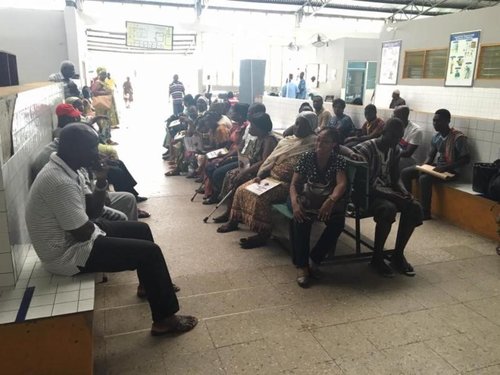
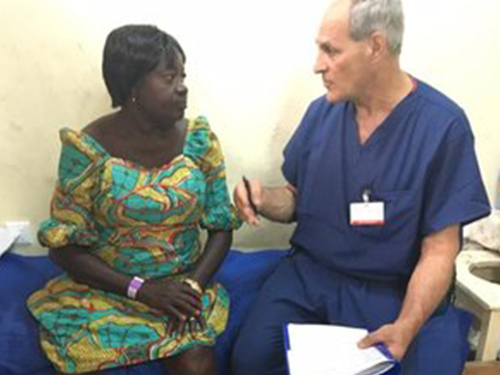
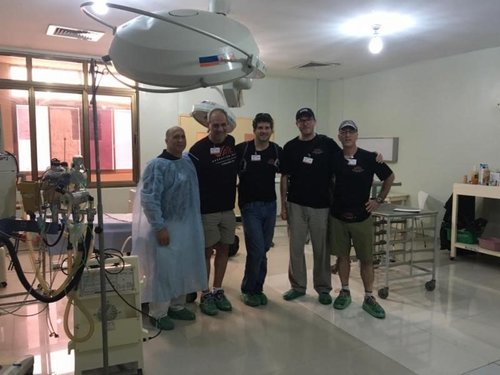
April 16, 2016
In medical school, we all learned that sickle cell trait, while profoundly destructive to the joints, was genetically protective against malaria. It’s an odd quirk of genetics, one that has allowed sickle trait to be naturally selected for in certain parts of the world, despite its negative effects. Individuals with sickle trait are protected against contracting malaria, and so they survive preferentially, long enough to put their genes into the gene pool. But, training and practicing in America, physicians just filed that away as esoterica. None of us ever really saw it in practice.
Well… here it is in the real world. The vast majority of patients we are seeing this week in Africa have a destructive hip arthritis that is directly secondary to their sickle cell trait – a trait that has thus far protected them against malaria, which remains endemic throughout much of the African subcontinent.
Today was Screening Day for Operation Walk Syracuse in Ghana, Africa. At 7:30 a.m., as the heat of the day presented itself, so did about 100 potential surgical candidates, who quickly filled the waiting area at St. Joseph Hospital in Koforidua.
It didn’t take us long to recognize the trend: patient after patient presented today with a very advanced, destructive hip arthritis secondary to a process called “AVN,” or avascular necrosis. Again, it’s a disorder that we see only rarely in the US. But today, we saw it over and over and over again, and mostly in patients in their twenties and thirties.
Each patient was interviewed and examined by our surgeons and nurses, and their surgical candidacy was assessed. Then a long, hot afternoon session of Grand Rounds helped us pare down the total to a manageable week of surgical patients. By definition, our resources are limited, but we are committed to doing as many cases as we possibly can. We will work fast, but it’s still most important for us to work safe.
And finally, in the late afternoon, we get the ball rolling with our first surgical cases of the week. Two teams, two rooms, one hip replacement and one knee replacement… done.
Tomorrow we start the surgical phase of our trip with focus – the goal is eleven joints a day for four days.
Unique challenges are presenting themselves: we have many more scheduled hips than knees… Koforidua seems to have pretty regular rolling blackouts… and even though the primary spoken language in Ghana is English, there is actually a need for English-to-English translators, as the dialects and accents are so different from our American versions. But we are determined to bring our expertise and efficiency to bear in this environment, help teach the local providers how to work more effectively, and change some lives while we’re at it.
April 24, 2016
A bird sang outside the window. A dog pushed its nose under my arm. The first mauslin-covered light of morning crept its way into the room. Morning. And I realized: I am in my own bed.
Coffee. Today there is going to be real coffee.
I have ruminated on the wonders of modern transportation for so many years that any mention of it makes my teenagers roll their eyes in anguish (which means: I am doing it just right. #dad!).
But instead of growing accustomed to the remarkable way we humans can move around our planet, I seem to become only more astounded by it. Did you ever fly over the Rocky Mountains? Could you do it in a covered wagon? In an afternoon? No. Nope.
Imagine that phone call: “Mom? Hi. Listen, we’re in Chicago, and we are delayed. Yeah… the oxen died. And Timmy has Yellow Fever. So instead of October, it’s going to be next June.”
In 1750 – less than 300 years ago, and just the blink of an eye in the grand expanse of human history – a journey from Africa’s Gold Coast to central New York would have taken at least 4 months, and 3 of them would’ve been on a wooden sailing ship crossing the unpredictable Atlantic Ocean. No weather reports, no satellite images, no communication whatsoever.
Yesterday, the members of Operation Walk Syracuse made that journey in around 21 hours. Woke up in Ghana, went to bed in Syracuse. I mean… come on. Think about that.
Our arrival home and subsequent dispersal has lent itself to a sort of hangover effect. This morning I will sit down at breakfast without all those people. And it seems odd.
Those people. The thing I cannot adequately describe – the thing that altogether defies words – is the feeling I have every time I think about what the people of Op Walk Syracuse have done. The nurses, the therapists, the techs, the support staff… each person worked 12-14 hour days in 90° heat, maximizing their individual contributions of expertise to a community of disabled people that otherwise would have had no access to orthopedic care. Ever.
And – here’s the thing – they each took personal vacation time to do it. This blows me away, every time I think about it.
Those people – they don’t work FOR Operation Walk. They don’t work WITH Operation Walk. They ARE Operation Walk.
Everywhere we went in Ghana, there were TV cameras. Microphones. Interviews. A groundswell of media attention followed our progress closely. Lots and lots of people in Ghana were watching.
A stone thrown into a still pond creates a circumferential ripple that propagates in every direction. And the stone that these Op Walk people have thrown… I think it’s entirely possible that its ripple will spread through Ghana, and even Western Africa, and help change the way the population thinks about health care.
Maybe the people of Op Walk touched more than 46 people. Maybe they touched millions.
I know I speak for all of the docs at Op Walk when I say: Thank you. Our hats are off to you. You carefully plucked the gossamer concept of Op Walk from the clouds and gave it real wings. And it flew. Man, did it fly. 1% inspiration, 99% perspiration. Great work.
Nice to be home. Lovely to wake up in our own beds. Can’t wait for the next trip.
Now… coffee.
Panama : 2012 &
2013
An Operation Walk team traveled to Panama City, Panama in 2012 and returned in 2013 to build upon the work started in 2012. Operation Walk’s mission is to give life changing surgeries to those who do not have the resources to lead productive lives without it. During the second trip to Panama the team saw many past patients, and was able to give them their second joint replacement, granting them further independence, motility, and a pain free life. Team members included Doctors, Anesthesiologists, Nurses, Physical Therapists, Surgical Techs, and other professionals.
PANAMA IN 2012 AND 2013
Location: Central America (Costa Rica to the North and Columbia to the South)
Capital: Panama City
Total Population: 3,941,375
Average Life Expectancy: 76.8
Independence: November 3, 1903
GDP per capita: $15,900
The average person makes $2.00 per day.
Prior to the trips all the equipment needed was bought, donated, or paid for with the donations collected through fundraising efforts. The eight tons of cargo was sent over two months in advance, and was waiting for the volunteers to unpack when they arrived. Operation walk Syracuse worked at the largest hospital in Panama, Hospital Santo Tomas, which was founded in 1702. The hospital had a special wing for Operation Walk to work in.
First, the team screens patients to determine who is most in need for the life changing surgery. Many patients have been living with pain for more than 10 years. The pain has claimed the patients freedom, and in many cases the ability to support themselves financially.
This surgeries provided will give these patients the opportunity to live a pain free life, and to be able to provide for their families. In 2013, 69 patients were selected to receive a joint replacement.
The surgeries were performed over four days, with most days starting at 7 am and sometimes finishing by 7 pm. Our doctors worked alongside a local team to a provide hands-on educational experience so once the doctors return to the US, the healing process will be able to be continued. In 2013, 74 joint replacement surgeries were performed.
After surgery,the patients typically begin physical therapy the same day as their surgery. They are generally accustomed to so much pain prior to their surgeries that they are able to handle the post-op pain and the challenges of physical therapy with smiles on their faces, and a great motivation to work towards achieving a pain free life.
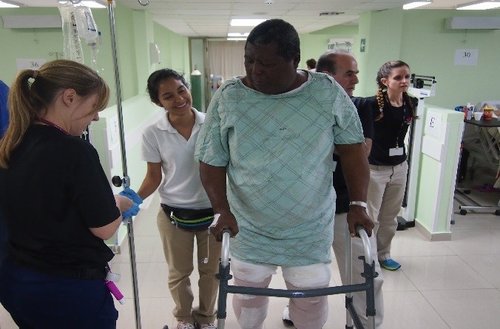

KATHMANDU, NEPAL : NOVEMBER 2011
Operation Walk Syracuse undertook its first mission abroad, to Kathmandu, Nepal. Nepal, a country with only one physician per 20,000 people, is in great need of specialized medical care. In cooperation with the Nepalese Ministry of Health, four orthopedic surgeons, anesthesiologists, and operative teams (about 50 people in total) traveled for a 9-day mission to complete 75-100 total-joint replacements.
Operation Walk Syracuse built four of their own operating rooms in Nepal so that all of the surgeons could operate the entire day for the duration of the mission. The operative teams brought every piece of equipment that could possibly be needed in the joint replacement surgeries and post-operative care. To that end, about 15,000 pounds of supplies were shipped to Nepal prior to the mission.
Medical education was an important component of the November 2011 mission. Nepalese doctors observed and assisted in the surgery so that they could gain exposure to the latest orthopedic surgery techniques and technologies. The Operation Walk team also included physical therapists who trained local practitioners to appropriately care for the patients after the teams departure.
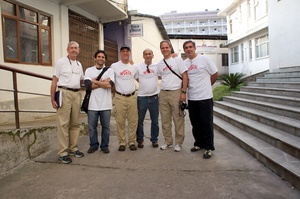


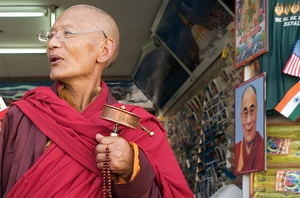
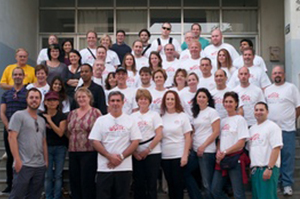
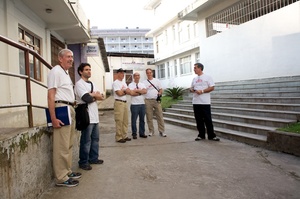
Contact Us For More Information
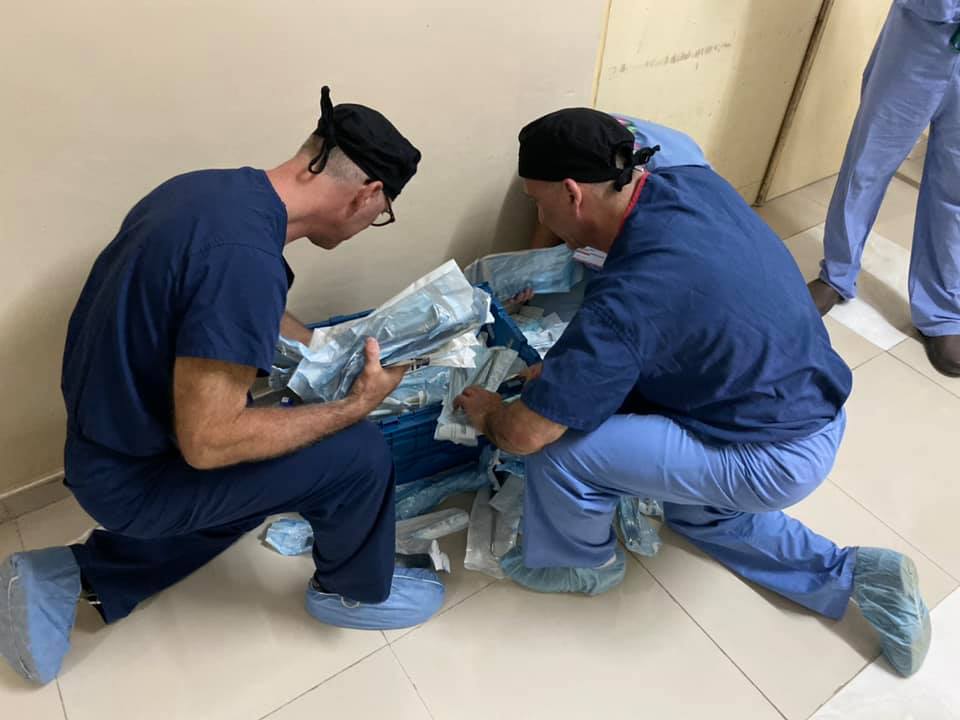
Location
Operation Walk New York
5786 Widewaters Parkway,
Syracuse, NY 13214
(315) 883-5875
